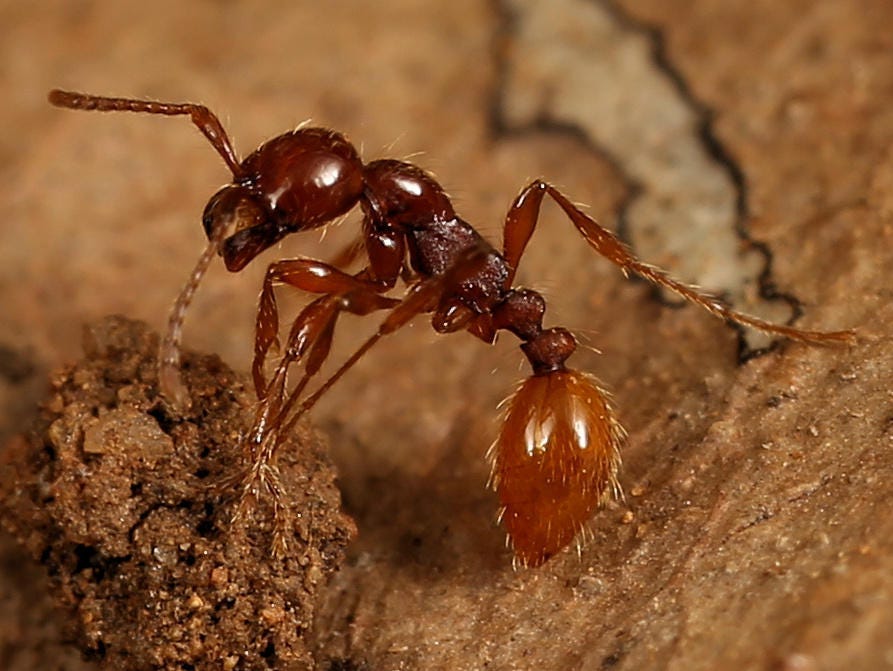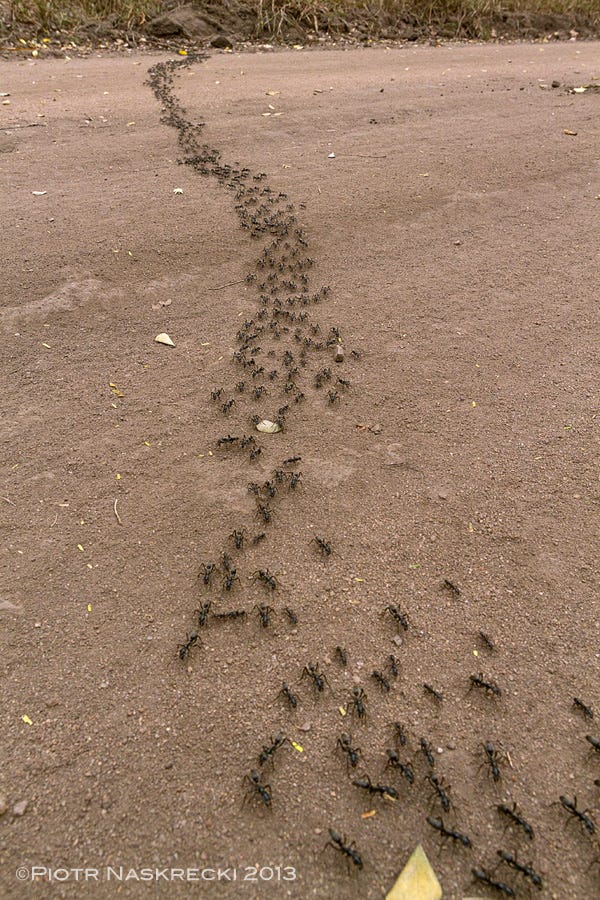Introduction
Army ants are one of nature's most specialized groups, they manage to orchestrate massive raids and live nomadically among their ecosystems. There are many species of army ants, with the most known being Eciton burchellii. Army ants are also classified into New World Army Ants and Old World Army Ants. The distinction between the two will be made in the following section. There is much to unpack in the world of army ants.
Behaviors
Army Ants are heavily studied, particularly species like Eciton burchellii and Dorylus nigricans, and much has been learned about their lifestyles and behavioral tendencies.
Their infamous raids—their most defining trait—will be addressed in a later section.
Additionally, Army Ants live nomadically, meaning they don’t stay in one place. At night, most species will create bivouacs. Bivouacs act as temporary nests and are made of ants clinging together to form walls. Here, eggs are laid, food is consumed, and other nesting duties are performed. When day time arrives, the bivouacs quickly dissolve and the ants get back to work, often leaving a wake of destruction behind them.
Classifying Army Ants
There are two classifications of army ants: New World and Old World.
New World ants belong to the ecitoninae subfamily in Central and South America. These ants often form smaller colonies and partake in column raids. New World ants specialize in eating social insects. The most prevalent species of New World ants is Eciton Burchellii. E. burchellii is the most studied army ant species in the world, with hundreds of pages of research examining them.
On the flip side, Old World ants often form larger colonies and perform looser carpet raids. They are also blind and depend on strong pheromone signals. Additionally, they are primarily found in Africa, with most villagers fearing their spiteful raids. The most prevalent Old World species is Dorylus nigricans. These ants are found in central Africa and regularly perform column raids, branching off of the usual carpet raids used by Old World ants. Another honorable mention would be the Aenictus genus. Aenictus ants are infamous for engaging in myrmecophagous, the process of eating other ants. These ants raid other nests and steal the brood for later consumption, often destroying the raided colony.
Aenictus sp. Worker
Types of Raids Used by Army Ants
There are two main raids used by army ants: column raids and carpet raids. Other raiding tactics exist, but none are prevalent enough to study and understand.
Column raids involve a thin line of ants, often 2-3 ants wide, and span very long distances, up to 1 kilometer. This style of raid, as mentioned above, is primarily used by New World Army Ants. This tactic is best for efficiency and defense. Thin columns can travel faster, and less surface area needs to be protected. With that being said, this style of raid falters in prey detection due to the narrow formation that can miss very large pockets of insects, causing the ants to miss out on a significant food opportunity. These columns are also heavily dependent on pheromones, with the smallest disruption creating the largest impacts, such as rain washing away the scent or obstacles that resist pheromones sticking to them, such as hard surfaces. These raids leave a large wake of destruction, destroying everything in their path.
Army Ant Column Raid (species unknown)
Carpet raids—used primarily by Old World ants—involve a less linear, broad area, often taking up hundreds of square meters of space instead of creating kilometer-long columns. In this area, ants often form circles or other dynamic shapes to sweep up everything trapped inside. This tactic is more effective for exploiting large populations of insects, such as termite mounds or insect breeding grounds. It falters when all resources in the area are depleted and a mass relocation is needed. This tactic affects more localized areas of the ecosystem compared to column raids, mainly due to the centralized nature of the raid. Unfortunately, there were no good pictures of this raid on Google.
Closing
Overall, army ants are a force to be reckoned with, often causing ecological destruction en masse in their wake. These ants are ruthless and will do anything for food. With colonies growing in the millions, they are an unstoppable force that exert massive influence on their ecosystems. Like warlords in a civil war, these ants call the shots and enforce their own rules, paying no mind to what is best for others.





Army ants, who knew? I guess I don't know much about ants except when they are invading my kitchen...This was undoubtedly the most unusual bedtime story I've read so far...you are nmber 324 :)